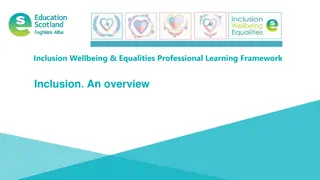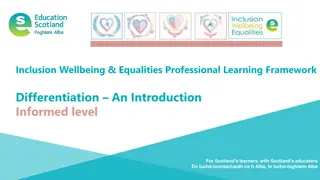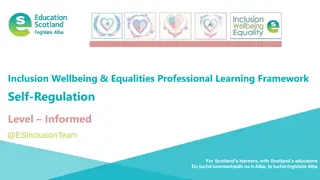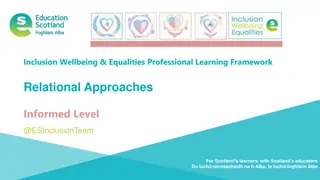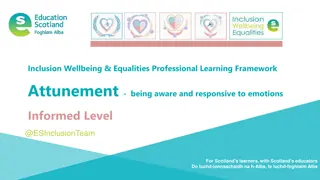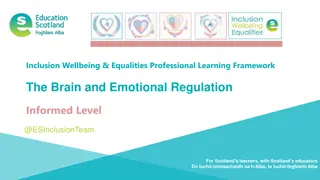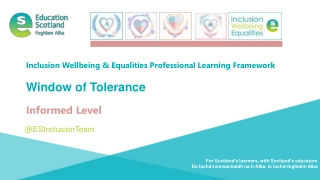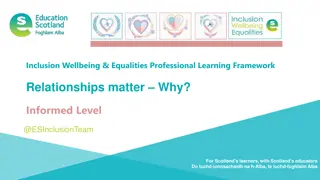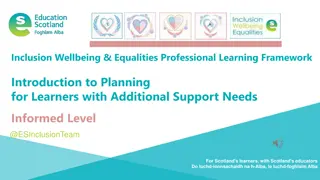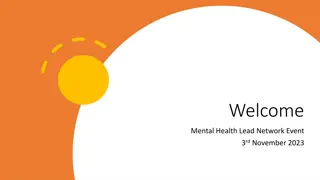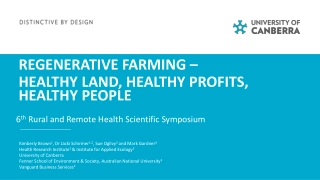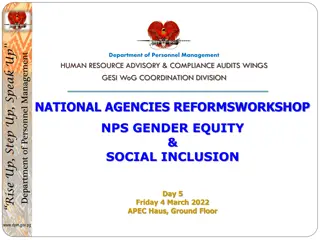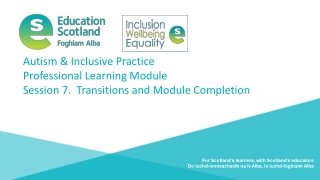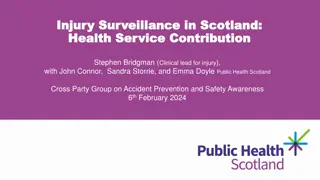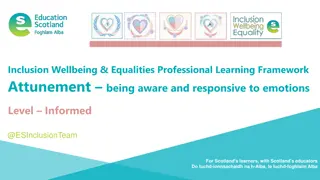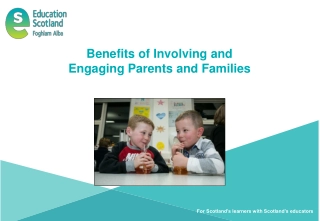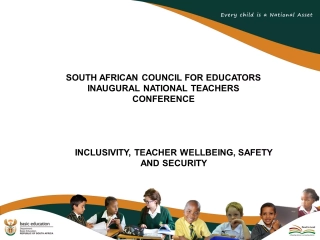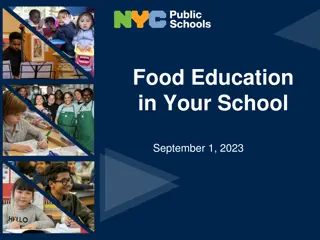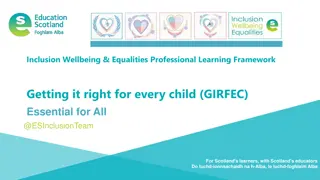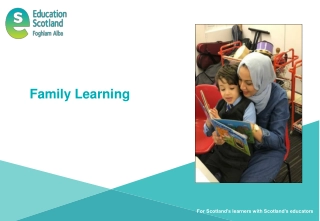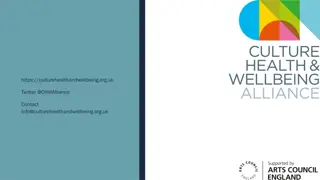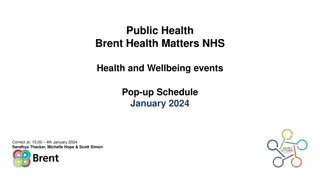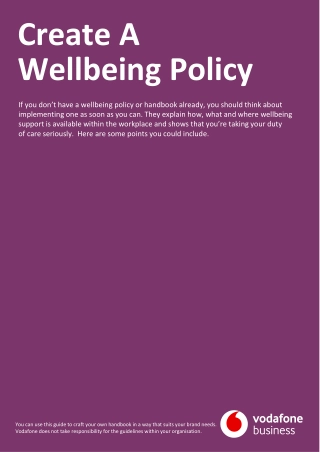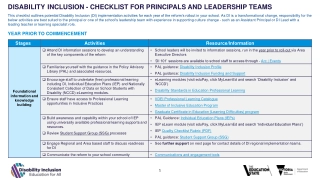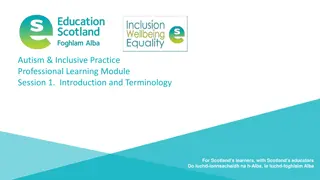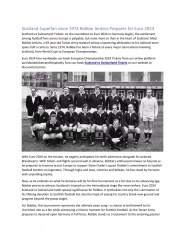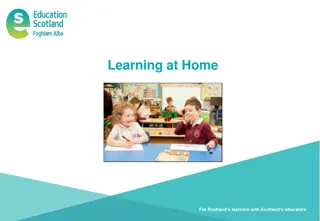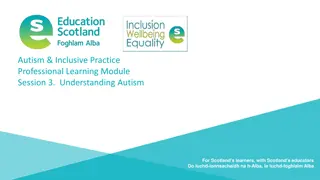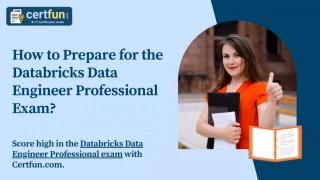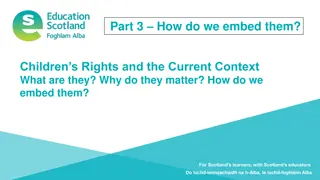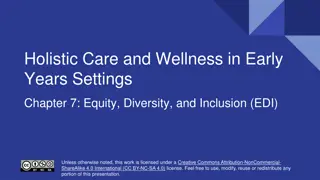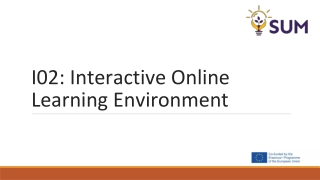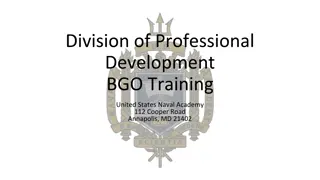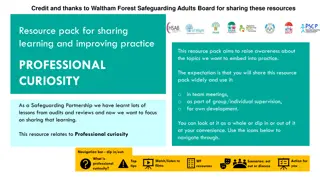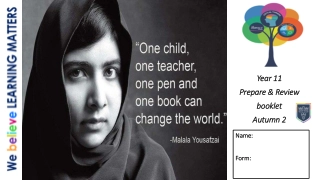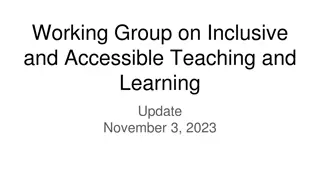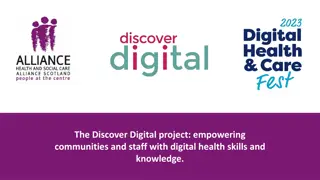Professional Learning for Inclusion and Wellbeing in Scotland
Explore the Inclusion, Wellbeing, and Equalities Professional Learning Framework for Scotland's educators and learners. This resource focuses on Regulate, Relate, Reason, and Restore in the engagement sequence to enhance the learning experience. Facilitate discussions using the provided slides and foster a safe space for reflection and growth. Dive into the Neurosequential Model and understand the importance of Restore in educational settings. Take advantage of this professional learning opportunity to deepen your knowledge and develop strategies for supporting learners in Scotland.
Professional Learning for Inclusion and Wellbeing in Scotland
PowerPoint presentation about 'Professional Learning for Inclusion and Wellbeing in Scotland'. This presentation describes the topic on Explore the Inclusion, Wellbeing, and Equalities Professional Learning Framework for Scotland's educators and learners. This resource focuses on Regulate, Relate, Reason, and Restore in the engagement sequence to enhance the learning experience. Facilitate discussions using the provided slides and foster a safe space for reflection and growth. Dive into the Neurosequential Model and understand the importance of Restore in educational settings. Take advantage of this professional learning opportunity to deepen your knowledge and develop strategies for supporting learners in Scotland.. Download this presentation absolutely free.
Presentation Transcript
Inclusion Wellbeing & Equalities Professional Learning Framework Regulate-Relate-Reason-Restore: The Sequence of Engagement Informed Level @ESInclusionTeam For Scotland's learners, with Scotland's educators Do luchd-ionnsachaidh na h-Alba, le luchd-foghlaim Alba For Scotland's learners, with Scotland's educators Do luchd-ionnsachaidh na h-Alba, le luchd-foghlaim Alba
Interconnectivity For Scotland's learners, with Scotland's educators Do luchd-ionnsachaidh na h-Alba, le luchd-foghlaim Alba
How to use this resource These slides can be used to facilitate professional learning in a group or whole-setting, or as a self-directed learning activity as an individual. Facilitation notes are included at the bottom of each slide. Please do not remove or change any of the slides included. Facilitators are welcome to add slides or activities relevant to your own setting, to support discussion and exploration of the topic. Facilitators will know their participants needs best. Anyone who works in an educational setting can be a facilitator and use these slides. For reflection or discussion activities, it is important to establish a safe space which encourages respect and honesty to ensure that everyone is able to participate. For Scotland's learners, with Scotland's educators Do luchd-ionnsachaidh na h-Alba, le luchd-foghlaim Alba
National Model for Professional Learning This professional learning resource will support you to deepen your knowledge and understanding. You will have the opportunity to consider how to take this learning forward on your own and with others. The National Model of Professional Learning (education.gov.scot) For Scotland's learners, with Scotland's educators Do luchd-ionnsachaidh na h-Alba, le luchd-foghlaim Alba
Welcome This session provides an opportunity to: To explore The Neurosequential Model & The Sequence of Engagement (RRR) To consider a 4thR Restore To understand the why and the how behind Regulate, Relate, Reason and Restore For Scotland's learners, with Scotland's educators Do luchd-ionnsachaidh na h-Alba, le luchd-foghlaim Alba
The Sequence of Engagement (The Neurosequential Model) 6:39 min From The Neurosequential Network If viewing as a PDF please click this link to watch the film https://youtu.be/_3is_3XHKKs For Scotland's learners, with Scotland's educators Do luchd-ionnsachaidh na h-Alba, le luchd-foghlaim Alba
The Sequence of Engagement The 3 Rs plus 1 Based on Bruce Perry s 3 R s: Reaching the Learning brain Regulate Relate Reason Restore and Louise Bloomer s 4th R For Scotland's learners, with Scotland's educators Do luchd-ionnsachaidh na h-Alba, le luchd-foghlaim Alba
1. Regulate (sensory brain) - through co-regulation Why do we need to help a learner regulate? How do we help a learner regulate? Offer soothing but limited words to comfort and re-assure Provide or create a safe space for them Allow them time to process and recover Use quiet tones Make sure they re comfortable (think sensory tolerances and physical needs ) Ensure they are with a trusted regulated adult They can t learn or reflect when they are in fight/flight/freeze/fawn mode, so their psychological stress responses need to be calmed FIRST. Stress brings on a pattern of psychological responses: hyper-arousal (jumpy, agitated, explosive) or hypo-arousal (depressed, withdrawn, frozen). See Window of Tolerance Module See Co-regulation & Calming Together For Scotland's learners, with Scotland's educators Do luchd-ionnsachaidh na h-Alba, le luchd-foghlaim Alba
2. Relate (emotional brain) - through connection Why do we need to relate to a learner? How do we relate to a learner? Use calm sensitive dialogue This connection will help to calm their nervous system. Help them name their emotions When we are around people we care about & Acknowledge and validate how they feel trust, our bodies produce oxytocin, the hormone Connect with them - attune and empathise (see Attunement Module) responsible for calming our nervous system after stress. Share your own experiences of that emotion (only share what is safe to share) See The 3 Brains & The Cranial Cocktail Empathy is a quality in which one person understands the perspective of another, accepts this perspective as belonging to the other person and conveys this understanding and acceptance back to the person . Sometimes empathic communication can pave the way for some joint problem solving. Golding 2006: 102 For Scotland's learners, with Scotland's educators Do luchd-ionnsachaidh na h-Alba, le luchd-foghlaim Alba
3. Reason (thinking brain) - through learning Why do we need to help a learner reason? How do we help a learner reason? Now: Now they are calm, they are in a mindset to learn Support them to remember and reflect Actively listen Help them to understand their feelings and that they are normal Help them reframe the situation if necessary Support them to explore strategies that help them to find calm (even practice some of the strategies) Long-term: Teach them the language of emotions Hopefully next time they feel this emotion they will have helpful strategies to rely on. Talk about regulation techniques Remind them about safe places & people For Scotland's learners, with Scotland's educators Do luchd-ionnsachaidh na h-Alba, le luchd-foghlaim Alba
4. Repair and Restore through relationships & reflection Why bother? How do we help a learner go about this? To repair relationships, rebuild trust, and/or open the lines of communication again if they have been damaged Think together to explore: What happened (including thoughts and feelings)? Allows them to tell their story, feel heard, and encourages them to be responsible and take ownership of resolving the situation How have others been affected? What needs to happen now to fix things? How can we help them repair the situation? Allows them, and others affected, to get back into their routine and to be ready to learn again See Relational Approaches Module For Scotland's learners, with Scotland's educators Do luchd-ionnsachaidh na h-Alba, le luchd-foghlaim Alba
How do we help someone who is dysregulated? ReflectionActivity (individually or as a group): What can we do help someone to regulate? What can we relate to someone? What do we need to consider when reasoning with someone who has been dysregulated? What do we need to do next? For Scotland's learners, with Scotland's educators Do luchd-ionnsachaidh na h-Alba, le luchd-foghlaim Alba
Reflection From what you have learned so far, think about: How has this made you feel? What has this made you think about? What one action would you like to take forward? How can you link what you plan to do with others in your setting? How you will know that this learning has made a difference? For Scotland's learners, with Scotland's educators Do luchd-ionnsachaidh na h-Alba, le luchd-foghlaim Alba
Resources and Information to help For Scotland's learners, with Scotland's educators Do luchd-ionnsachaidh na h-Alba, le luchd-foghlaim Alba
We value your feedback From now until March 2024 we will be taking feedback on these resources so that we can make changes in advance of a formal launch of the Professional Learning Framework in June 2024 Your feedback could help us improve this resource Please complete this short form, using the link or QR code, to let us know what you thought of it and any suggestions you have on how it could be improved LINK: https://forms.office.com/e/b5PCpJJJ3P For Scotland's learners, with Scotland's educators Do luchd-ionnsachaidh na h-Alba, le luchd-foghlaim Alba
Education Scotland Denholm House Almondvale Business Park Almondvale Way Livingston EH54 6GA T +44 (0)131 244 5000 E enquiries@educationscotland.gsi.gov.uk For Scotland's learners, with Scotland's educators Do luchd-ionnsachaidh na h-Alba, le luchd-foghlaim Alba For Scotland's learners, with Scotland's educators Do luchd-ionnsachaidh na h-Alba, le luchd-foghlaim Alba


